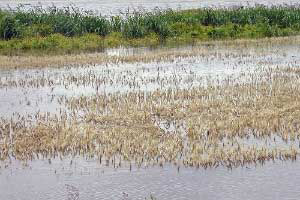Research: Influence of waterlogging on wheat

A joint research by the Department of Agriculture and Food’s Grains Industries, India’s Central Soil Salinity Research Institute and University of WA was conducted into the effects of waterlogging relative to drained conditions on grain yield in the hope of casting light on how different varieties respond in different environments.
“We could never repeat results from different countries—it was a total mystery,” Professor Tim Setter, one of the paper’s authors said. “What we discovered was that any of the background element toxicities in the soil become amplified many times due to waterlogging.
“The waterlogging itself reduces the plant’s energy and knocks out its ability to exclude toxic elements which can normally be handled.
“Some of these elements, such as iron and manganese, increase from 10 to 50 times due to waterlogging.
“All of a sudden there is a whole suite of complex elements to deal with that can increase in amount and these different elements mean different soils.”
In addition to iron and manganese, other element toxins include boron, aluminium, bicarbonate, and sodium.
“Waterlogging affects growth because it limits the oxygen supply to the roots,” Professor Setter says. “The oxygen travels about 10,000 times more slowly through water than the air space that normally occurs in soil.
“When soils are waterlogged, it’s like an immediate suffocation.”
While the problem of waterlogging is complex, Professor Setter stresses it is not complicated.
“The word complex implies you can unravel the bits and that’s what we’ve got here,” he says. “We’ve got a collection of matrices and different key components we need to unravel.”
Using five breeding teams (two in Australia, three in India), researchers first explored different waterlogging problems in each location.
From there, breeders and geneticists were used to screen germplasm and molecular biologists then identified which key genes were important to combine to make the germplasm waterlogging-tolerant in multiple environments.
“We’ve been able to identify material that will probably yield up to three times higher in an Australian environment and certainly yield about 20–25 per cent higher than the highest yielding commercial varieties,” Professor Setter says.
“We’re increasing its tolerance through breeding programs and are currently involved with developing a molecular marker to enable the breeding companies to be able to follow the same path.”











